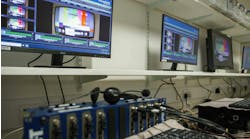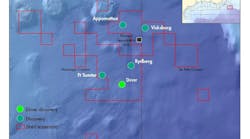With an important series of tests completed in Norway last month, and final installation expected spring of next year, ABB's Subsea Separation and Injection System (Subsis) is close to becoming a reality.
The first Subsis delivery constitutes the Troll Pilot Project, forming part of the second phase of development of the Troll oil reserves under Norsk Hydro. Although the technology has yet to be proven in practice, the operator expects water breakthrough at an early stage, and therefore sees benefits from subsea separation in the shape of reduced flowline and topside processing requirements.
Subsis is simple in concept - water is separated from oil and gas in a separator and either discharged to the sea or, as in the Troll Pilot case, re-injected beneath the seabed. However, a number of significant technological gaps have to be filled to make the idea work in practice. In the case of Troll Pilot, there are two major gaps.
One is the development of a high-voltage subsea mateable connector, Mecon. A further sub-project has been concerned with the development of a reliable level indicator for monitoring the level of the oil/water interface, a crucial parameter for controlling the speed of the injection pump, and thereby controlling the liquid level in the separator.
Function, integration
Shallow water tests of the system, including 22 days of closed loop testing and 23 days of endurance testing, were carried out from January to June at Framo Engineering's Fusa test facility. These served to check the functionality of the control system, the injection pump, the umbilical connection, the Mecon connection, and the level transmitter.
Integration testing began in April and was due to finish in July. During this period, the 350-ton system was gradually put together at the Nymo yard in southern Norway, where the template was built. Along the way, interfaces were being tested and the equipment commissioned. The testing phase was going quite smoothly, according to Stig Gustafson, Manager of the subsea processing department at ABB Offshore Systems. "By the end of July, the system should be ready for delivery to Hydro," he said at mid-year.
The Troll Pilot will be installed some time this autumn in 350 meters of water by lift-vessel Maxita. Hinged, overtrawlable GRP protection covers will protect the equipment on the seabed.
Operation in 2000
The system, which will have the capacity to process 63,000 b/d of liquids and 800,000 cu meters/day of gas at water cuts of 0-90%, will be placed on the S cluster of wells in the Troll West oil/gas province. When it comes into operation in 2000, only two production wells will be on stream, but eventually there will be eight wells in the cluster.
Water separated out from the wellstream will be injected beneath the seabed into a dedicated well. Hydro has identified this as a hydrostatic well, which means that in a first phase, no pressure boosting will be required to inject the water. The water injection module therefore will be installed at a later stage, sometime in 2000.
The Subsis equipment is placed on a standard four-slot subsea template as supplied for the Troll subsea wells. The wellstream arrives in a single flowline, and passes into a standard gravity separator, about 10 meters long and 3 meters in diameter, where gas is first separated from the liquids, and secondly water from the oil. Sand is also separated out.
Semi-cyclone
Acting on an initial idea from Hydro, ABB has developed a novel inlet device known as a semi-cyclone which gradually reduces the momentum of the wellstream and thus prevents the formation of small droplets which would have reduced the efficiency of the separation process. A combination of two level monitoring systems, one nucleonic and one electric, monitors the oil/water interface.
Oil and gas are recombined through one nozzle for onward transport to the Troll C platform. Meanwhile, the water is conducted to the injection module and pumped down the injection well. Together, the module and pump stand 5 meters high and weigh 20 tons. This is the first time rotating machinery of this size has been placed on the seabed, said Gustafson.
The pump is a fairly conventional 2 MW, seven-stage centrifugal unit supplied by Framo, but what is new is the integration between pump and motor to counter external pressure. For ease of maintenance, the pump and the module can each be separately retrieved.
Power is delivered via an umbilical which connects to the water injection module through the Mecon high-voltage connector. The connector is a three-piece device, consisting of two sets of male parts and one set of female parts. Once the mini-spool containing the female parts has been mated with the umbilical and with the module, seawater is excluded from its internal chambers by a series of flushing operations using de-ionized water and ethanol. Finally, it is filled with non-conducting dielectric fluid. The spool can be separately retrieved.
For a single functioning unit such as the Troll Pilot, power can be supplied directly from the topsides. But as the technology for subsea processing and other functions proves itself, ABB sees multiple functions being undertaken. For this purpose, it is now well advanced in the so-called Sepdis joint industry project for the development of a system for subsea power distribution. A single umbilical will deliver power from the topsides, and via a Mecon connector into a Sepdis unit housing a transformer, switchgear, and frequency converters, individual consumers will be fed. A full-scale prototype is due to be tested next year.
"Subsis has aroused interest around the world, and a lot of companies have brought subsea separation into their new technology portfolios," Gustafson said. ABB has performed many studies, ranging from conceptual to detailed design, and it appears that some companies are so keen to implement the technology that they may not wait to see the results of the Troll Pilot.


